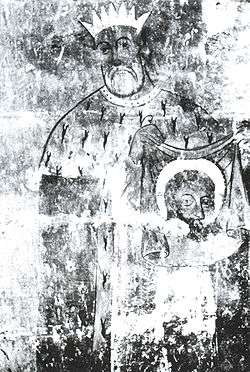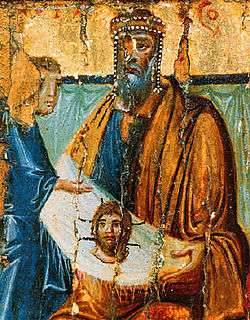Abgar V
| Abgar V of Edessa | |
|---|---|
| Ruler of the kingdom of Osroene | |
|
Icon of Abgar holding the mandylion, the image of Christ (encaustic, 10th century, Saint Catherine's Monastery, Mount Sinai). | |
| Died | c. 40 |
| Spouse | Helena of Adiabene |
Abgar V the Black or Abgarus V of Edessa (Syriac: ܐܒܓܪ ܚܡܝܫܝܐ ܐܘܟܡܐ; ʾAḇgar Ḥəmīšāyā ʾUkkāmā, Armenian: Աբգար Ե Եդեսացի; Abgar Hingerord Yedesatsi, Ancient Greek: Ἄβγαρος Abgaros) (BC 4 – AD 7 and AD 13–c. 40) was a historical Arab ruler of the kingdom of Osroene,[1] holding his capital at Edessa.[2]
He was converted to Christianity by Mar Addai one of the Seventy-two Disciples.[3]
Life
Abgar V was one of the first Christian kings in history, having been converted to the faith by the Apostle Thaddeus of Edessa.[4]

Moses of Khoren says that the chief wife of King Abgar V was Queen Helena of Adiabene, the wife of King Monobazus I of Adiabene, and thus the kingdoms of Edessa and Adiabene were linked in some manner. Professor Robert Eisenman suggests that Queen Helena was the sister-wife of King Abgar V who was given the lands of Adiabene by her brother-husband, the king.[6] Professor Eisenman derived this association from Moses of Chorene mentioning the same famine relief to Judaea as does Flavius Josephus:[7]
- "The chief of King Abgar’s wives, who was named Helena ... Helena went away to Jerusalem in the time of Claudius, during the famine which Agabus had predicted. Spending all her treasures she bought an immense amount of grain in Egypt, which she distributed to the poor, to which Josephus bears witness. Her famous mausoleum stands before the gate at Jerusalem to this very day.:[8]
Professor Eisenman goes on to equate King Abgarus with the Agabus in Acts of the Apostles (Acts 11:27-30), because Agabus was identified with the same famine relief as Queen Helena. By necessity Eisenman then equates the biblical Antioch Orontes with Antioch Edessa, indicating that Saul-Paul and Barnabas went to Edessa.[7][9]
The Letter of King Abgar to Christ
The church historian Eusebius, Bishop of Caesarea records [10] that the Edessan archives contained a copy of a correspondence exchanged between Abgar of Edessa and Jesus.
The correspondence consisted of Abgar's letter and the answer dictated by Jesus.

On August 15, 944, the Church of Saint Mary of Blachernae in Constantinople received the letter and the Mandylion. Both relics were then moved to the Church of the Virgin of the Pharos.[11]
The account of this enjoyed great popularity in the East, and also in the West, during the Middle Ages: Jesus' letter was copied on parchment, inscribed in marble and metal, and used as a talisman or an amulet. Of this correspondence, there survive not only a Syriac text, but an Armenian translation as well, two independent Greek versions, shorter than the Syriac, and several inscriptions on stone.
A curious growth has arisen from this event, with scholars disputing whether Abgar suffered from gout or from leprosy, whether the correspondence was on parchment or papyrus, and so forth.
The text of the letter was:
Abgar, ruler of Edessa, to Jesus the good physician who has appeared in the country of Jerusalem, greeting. I have heard the reports of you and of your cures as performed by you without medicines or herbs. For it is said that you make the blind to see and the lame to walk, that you cleanse lepers and cast out impure spirits and demons, and that you heal those afflicted with lingering disease, and raise the dead. And having heard all these things concerning you, I have concluded that one of two things must be true: either you are God, and having come down from heaven you do these things, or else you, who does these things, are the son of God. I have therefore written to you to ask you if you would take the trouble to come to me and heal all the ill which I suffer. For I have heard that the Jews are murmuring against you and are plotting to injure you. But I have a very small yet noble city which is great enough for us both.[12]
Jesus gave the messenger the reply to return to Abgar:
Blessed are you who hast believed in me without having seen me. For it is written concerning me, that they who have seen me will not believe in me, and that they who have not seen me will believe and be saved. But in regard to what you have written me, that I should come to you, it is necessary for me to fulfill all things here for which I have been sent, and after I have fulfilled them thus to be taken up again to him that sent me. But after I have been taken up I will send to you one of my disciples, that he may heal your disease and give life to you and yours.[13]
Egeria wrote of the letter in her account of her pilgrimage in Edessa. She read the letter during her stay, and remarked that the copy in Edessa was fuller than the copies in her home (which was likely France).[14]
Liturgical use of the letter of Abgar
In addition to the importance it attained in the apocryphal cycle, the correspondence of King Abgar also gained a place in liturgy for some time. The Syriac liturgies commemorate the correspondence of Abgar during Lent. The Celtic liturgy appears to have attached importance to it; the Liber Hymnorum, a manuscript preserved at Trinity College, Dublin (E. 4, 2), gives two collects on the lines of the letter to Abgar. It is even possible that this letter, followed by various prayers, may have formed a minor liturgical office in some Catholic churches.[15]
Christian legacy
| Saint Abgar | |
|---|---|
| Venerated in | Eastern Orthodox Church, Syrian Orthodox Church, Armenian Apostolic Church |
.jpg)
This event has played an important part in the self-definition of several Eastern churches. Abgar is counted as saint, with feasts on May 11 and October 28 in the Eastern Orthodox Church, August 1 in the Syrian Church, and daily in the Mass of the Armenian Apostolic Church. The Armenian Apostolic Church in Scottsdale, Arizona, is named after Saint Abgar (also spelled as Apkar).
On August 24, 2009, the board of the Central Bank of Armenia adopted a decision on introducing a new banknote with a nominal value of AMD 100,000. The new banknote depicts King Abgar V (King of Armenian Mesopotamia as described). The front of the banknote depicts Abgar pointing at the royal flag bearing an image of the Mandylion. The reverse of the banknote depicts disciple Thaddaeus handing the canvas to King Abgar V and his consequent miraculous healing.[16]
See also
References
- ↑ Ball, Warwick (2002). Rome in the East: The Transformation of an Empire. Routledge. p. 90. ISBN 9781134823871.
- ↑ Vailhé, Siméon. "Edessa." The Catholic Encyclopedia. Vol. 5. New York: Robert Appleton Company, 1909. 19 Dec. 2012
- ↑
 Herbermann, Charles, ed. (1913). "Doctrine of Addai". Catholic Encyclopedia. New York: Robert Appleton Company.
Herbermann, Charles, ed. (1913). "Doctrine of Addai". Catholic Encyclopedia. New York: Robert Appleton Company. - ↑ Fortescue, Adrian (December 2001). "Lesser Eastern Churches". ISBN 978-0-9715986-2-1.
- ↑ King Abgar illustration in 1898 book Illustrated Armenia and Armenians
- ↑ The Sociology of MMT and the Conversions of King Abgarus and Queen Helena of Adiabene, Professor Robert Eisenman. p8.
- 1 2 Jesus, King of Edessa. Ralph Ellis. Edfu Books, 2012.
- ↑ Moses of Chorene, History of the Armenians 2:35
- ↑ The Sociology of MMT and the Conversions of King Abgarus and Queen Helena of Adiabene, Professor Robert Eisenman. p1.
- ↑ In his Historia Ecclesiastica, I, xiii, ca AD 325.
- ↑ Janin, Raymond (1953). La Géographie ecclésiastique de l'Empire byzantin. 1. Part: Le Siège de Constantinople et le Patriarcat Oecuménique. 3rd Vol. : Les Églises et les Monastères (in French). Paris: Institut Français d'Etudes Byzantines. p. 172.
- ↑ http://www.newadvent.org/cathen/01042c.htm
- ↑ http://www.newadvent.org/fathers/250101.htm
- ↑ Bernard, John. "The Pilgrimage of Egeria". University of Pennsylvania. Palestine Pilgrims' Text Society.
- ↑ Leclercq, Henri. "The Legend of Abgar." The Catholic Encyclopedia. Vol. 1. New York: Robert Appleton Company, 1907. 24 Dec. 2012
- ↑ "CBA issues 100,000 Dram banknotes". PanArmenian News. Retrieved 2009-08-24.
Sources
| Wikisource has original text related to this article: |
- Walter Bauer, Orthodoxy and Heresy in Earliest Christianity, 1934, (in English 1971): On-line text
- Robert Eisenman, James the Brother of Jesus 1997 (Viking Penguin), especially ch. 24 "Judas the brother of Jesus" and the section "Thaddeus, Judas Thomas and the conversion of the Osrhoeans", pp 189ff.
- Ian Wilson, Holy faces, secret places 1991
- Robert Eisenman, James the Brother of Jesus 1997, especially ch. 24 "Judas the brother of James and the conversion of King Agbar"
- Holweck, F. G., A Biographical Dictionary of the Saints. St. Louis, MO: B. Herder Book Co., 1924.
- Acta Thaddei (Acts of Thaddaeus), Constantin von Tischendorf, Acta apostolorum apocr. 261 ff.
External links
-
 Herbermann, Charles, ed. (1913). "The Legend of Abgar". Catholic Encyclopedia. New York: Robert Appleton Company.
Herbermann, Charles, ed. (1913). "The Legend of Abgar". Catholic Encyclopedia. New York: Robert Appleton Company. - Ante-Nicene Fathers, vol. VIII: Acts of the Holy Apostle Thaddeus, One of the Twelve
- Epistle of Jesus Christ to Abgarus King of Edessa from Eusebius
- The Doctrina Addai as a Paradigm of Christian Thought in Edessa in the 5th century, by Sidney H. Griffith, Institute of Christian Oriental Research, Catholic University of America
- St. Apkar Armenian Apostolic Church of Arizona http://saintapkar.com
- Correspondence between Abgarus Ouchama, King of Edessa, and Jesus of Nazareth (J.Lorber, 1842)
